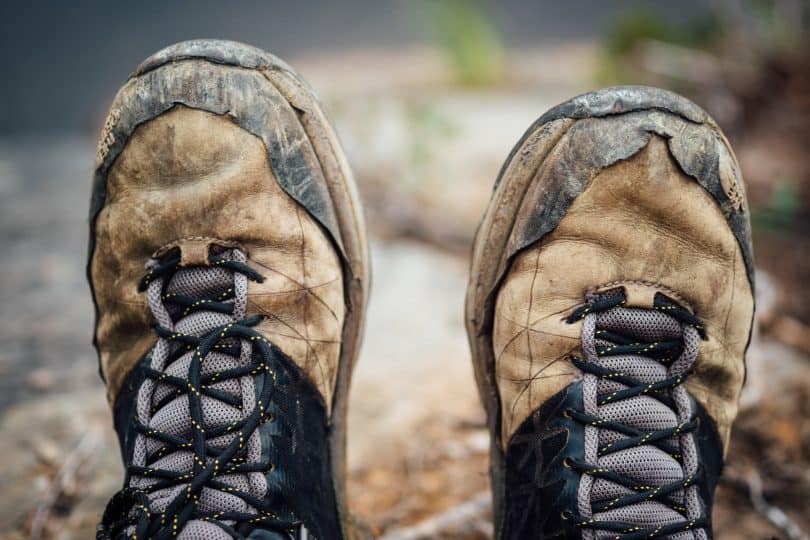When you go hiking, you need to prepare carefully: to pack a backpack, to choose proper clothing and additional equipment, to think about your meals and drinks and of course, to make sure that you have good and high-quality footwear.
Quality and solid boots or shoes are very important in hiking since you spend many hours walking in different landscapes and terrains. By choosing the right footwear you endow yourself with a comfortable, pleasant, and enjoyable outdoor experience.
Due to a great variety of types of footwear on the market today, it might be difficult to decide and make the right choice, and therefore this article might come in handy for you.
See also: Toddler Hiking Shoes: Buying the Best for Your Tiniest Trailblazer
This post will provide you with all the necessary information about hiking footwear and tell you about hiking shoes vs hiking boots, so you will know the difference between these two types of footwear.
The key differences between hiking boots and hiking shoes
Many beginners and sometimes even experienced outdoor lovers and hikers mistakenly believe that hiking boots and shoes are the exact same thing. However, in fact, there is a number of significant differences between them that you need to be aware of. Moreover, they both have their own advantages and disadvantages that need to be discussed in detail.
Function and purpose
When you decide to buy hiking shoes or boots, the first thing that you should consider is where, how long and under what conditions you are going to wear them. Thus, a pair of hiking boots is the best choice for mountaineering, heavy backpacking, long hiking journeys and hiking across winter landscapes with dry snow.
Some outdoor adventure seekers also take hiking boots with them in order to use for walking during sporting activities like mountain skiing or snowboarding.
Must read: Hiking Boot Laces: Best Laces to Outlast Your Boots
On the other hand, you should buy hiking shoes if you are going to hike through rough terrains and prefer short hiking walks with a light backpack. They are also perfect for activities like trail running and camping.
Weight
Since hiking boots are bigger and more solid than shoes, it is not a surprise that they are heavier. It might become an issue because hardly anyone wants to feel every single step and get tired easily on a hike. If you have heavy footwear, you will probably not be able to enjoy your hike fully.
For this reason, more and more hikers choose hiking shoes that are lighter and do not add additional weight to their feet. Moreover, it is also important to know that the heavier footwear you wear during a hike, the bigger stress you put on your back, which might lead to severe backache and even to more serious health problems with the spinal disks. For the best choice of minimalist hiking shoes, read our article for more insight.
In addition, many people also suffer from knee problems that are also caused by excessive footwear weight. Thus, it has been proven that if you wear for example a 3-pound hiking boot, it will be the equivalent of adding 15 pounds to your backpack. On the other hand, with a pair of hiking shoes that weigh a mere pound, it would be the equivalent of no more than 5 pounds to your pack, which is definitely more comfortable.
Breathability
Most solid hiking boots are made of leather which significantly reduced their breathability. Therefore, you should be prepared that sweat and moisture will be kept inside your boot which might become uncomfortable. However, more and more brands nowadays start producing hiking boots of high-quality waterproof materials which makes for better breathability.
With regards to hiking shoes, they are known instead for their good breathability: most models are designed in such a way that they allow fresh air inside and keep your feet dry. However, of course, everything will depend on the particular model that you choose.
Dry time
If your hiking boots get wet, you will probably have to wait for a long time to dry them. It might become a serious problem for long hikes that last for several days. The best thing that you can do is to keep your boots dry during the whole trip, though it is not always possible.
In terms of hiking shoes, most of them dry 30% quicker than hiking boots, therefore you will probably be more comfortable by wearing them, even if you get wet.
Durability
It is obvious that hiking boots are a better choice for you if you are looking for durability because compared to hiking shoes, they will likely last 25% longer. The average lifespan of hiking boots is around 1000+ miles, while regular hiking shoes have durability less than 750 miles.
Thus, if you are an active hiker and you plan to spend most of your free time outdoors, then a pair of hiking shoes is not the best choice for you since you will have to buy a new pair quite often.
Agility
If you decide to buy hiking boots, you should be prepared for limited agility: the heavier and more solid hiking boots are, the less possibility they give to your feet and ankles to move, which might give you an uncomfortable feeling of restriction. This is why you probably don’t want to use hiking boots for running.
Hiking shoes have thinner soles that are more agile which allow your foot to move more naturally and give the feeling of freedom to your ankles. With regards to agility, comparing hiking boots and shoes is like comparing tanks and cars: the bigger and heavier a vehicle is, the more problems it’ll have in terms of agility.
Water resistance
Though it has been mentioned above that hiking boots get dry very slowly, usually, it is not a problem at all because hiking boots don’t tend to get wet easily. Most leather boots are waterproofed quite well that even if you sink your feet into the water, they won’t get wet.
If they are not made of leather, then their water-resistance qualities will depend on the linen that is used to waterproof them. Thus, it is possible to say that in order to ensure the best choice of waterproof boots, it is worth buying a pair of leather ones.
However, in any case, you should remember that even the best, most solid, and expensive hiking boots are not completely water-resistant, so it’s better not to get them wet completely.
In contrast to hiking boots, shoes have a moderate level of water resistance, so the risk of getting your feet wet during a hiking trip is higher. When purchasing hiking shoes, it is also recommended to pay attention to the materials they are made of. Today, more and more brands produce good waterproof hiking shoes of Gore-Tex but this also means a higher price.
Support
Hiking boots are known for their great support that you will need if go for a long hike with a heavy backpack. Their level of support is some of the highest when it comes to footwear except for skiing or snowboarding shoes, but that’s a different topic altogether.
In terms of hiking shoes, though they don’t provide that much support this also means that they’re lighter. Hikers are going for hiking shoes for day-hike trips that last only a day or two. If you would like to test the level of support of your boots or shoes, take a shoe with one hand on its heel and with another hand on its toe, then try to twist it from side to side.
The stiffer sole of the shoe from side-to-side is, the better support the shoes will provide. Also, you should bear in mind that if you have weak ankles, then it is recommended to wear hiking boots during your hikes, even if they are quite short.
Protection of your feet
Due to the solid construction and thick sole of hiking boots, you can be sure that your feet are perfectly protected from bangs and scrapes when hiking in rocky and mountain terrains. Moreover, hiking boots also provide side support that protects the ankles from twists and sprains. For blister-free feet, check out our review of the top Gore-Tex hiking shoes for more information.
With a thick, strong, and firm sole you can be sure that you will not hurt the sole of your foot and will not come back home with injuries. However, it does not mean that hiking shoes is knowingly a bad choice: if you hike carefully and watch your step, you will not get hurt anyway. Furthermore, you can improve the level of protection of your hiking shoes by adding low-cut gaiters that are also known as trail gaiters.
Weather conditions
If you prefer to hike in the winter or autumn months when the weather is colder, then a pair of hiking boots will be a perfect choice. It is not recommended to use boots in warm seasons because their low breathability does not allow your sweat and moisture to escape, which often leads to blisters.
As a result, your summer hike can become absolutely uncomfortable and even painful. Therefore in the summertime, it is better to wear hiking shoes that provide you with perfect breathability even in the warmest weather conditions. Moreover, since they are lighter, you move more easily and in a relaxed way without extra sweating.
Also, remember about the temperature outside: if it is snowing and it is less than 40 degrees Fahrenheit, it is obviously not wise to wear hiking shoes – take hiking boots instead that are much warmer and are more suitable for walking on the cold ground. If the weather is too hot, hiking shoes are not automatically the best option. In such cases, it might be better to choose another type of footwear – a pair of hiking sandals.
Price
Due to the durability, high level of protection, and high-quality materials, hiking boots are usually much more expensive. An average price for a good pair of them is around $150-200, while a pair of hiking shoes will cost approximately $100.
If you would like to purchase the cheapest ones, then you should know that the lowest price for hiking boots is around $80, while the most expensive one can easily go above $300. With regards to hiking shoes, you can buy the cheapest pair by spending only $50+.
If you are interested in an expensive option, then be ready to pay more than $200. According to statistics, most people prefer hiking shoes – approximately 67%, while only 33% of hikers prefer hiking boots.
Ability to break-in
Breaking in is very important after you bought a new pair of shoes, especially if it is hiking footwear. You are probably familiar with that terrible experience of wearing new footwear for the first time: you feel uncomfortable, awkward, and sometimes even painful because shoes do not conform to your feet yet.
However, after several hours of wearing them, you become more comfortable since the shoes start compressing to the shape of your feet. This process of compressing is called breaking in and it applies to all types of footwear, including hiking boots and shoes. However, it is necessary to point out that it is much more important to break in your hiking footwear before your trip because comfort when outdoors is always priority number one.
Hiking boots and hiking shoes differ in their ability to break in. Thus, hiking boots being solid and firm are quite difficult to break in, and it might require much time to do it. Take it into consideration and try to break in your boots properly and for a longer period in order to make sure that they finally fit your feet.
Hiking shoes, on the other hand, are softer and tend to conform to the foot more easily. Usually in order to break in them, wearing them a number of times is enough. For more tips on how to break in new hiking boots, see our article for more information.
Final words
Comparing hiking boots and hiking shoes, you’ll see that they have many differences. In general, hiking boots provide better support and protection during hiking and walking through rocky and snowy terrains. They are warmer and more durable and you can wear them during longer hikes in winter. You can actually walk many miles without worrying that you will be cold or the boots will not survive your adventurous journey.
On the other hand, they have significant drawbacks as well: hiking boots are heavy, not well breathable, and quite expensive. Moreover, if you fail to break them in properly before your journey, it can become very comfortable and may even result in pain and blisters which can only make your trip worse.
Hiking shoes on the other hand are lighter, more agile, and, as a result, require less energy expenditure during walks. Moreover, they breathe better, and in contrast to boots, they cost less. However, if you plan to spend much time outdoors, you should be prepared to change your hiking shoes quite often and regularly buy a pair of new ones because their durability is quite low.
So, what type of hiking footwear you should choose? If you usually make short one-day hikes, then a pair of hiking shoes is the best choice for you. However, if you decide to leave for a long journey through different types of terrains, then we would recommend you to buy a pair of hiking boots.
Featured Image Source: https://unsplash.com/photos/wKMl3pkDsjk






